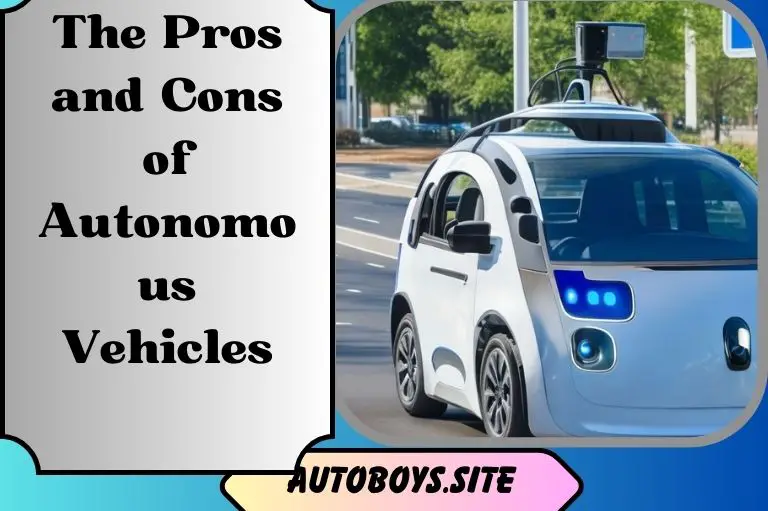Autonomous Delivery Vehicles: Transforming the Last-Mile Landscape
The rise of technology has paved the way for innovative solutions in various industries. One such breakthrough is the introduction of future autonomous delivery vehicles, which have the potential to revolutionize the last-mile landscape. Understanding the concept and key components of these vehicles is crucial in comprehending their impact and the future they hold.
Additionally, exploring the current challenges in last-mile delivery and the potential benefits autonomous vehicles can bring sheds light on the transformative power of this technology. Nevertheless, it is essential to consider the potential roadblocks and challenges that lie ahead, as well as the regulatory considerations necessary to ensure a smooth integration of autonomous delivery vehicles.
Understanding Autonomous Delivery Vehicles
The Concept of Autonomous Delivery Vehicles
Autonomous delivery vehicles refer to self-driving vehicles that are designed to transport goods from distribution centers to their final destinations without human intervention. These vehicles leverage cutting-edge technologies, such as artificial intelligence, sensors, and GPS, to navigate various terrains and deliver packages efficiently.
Imagine a world where delivery vehicles seamlessly navigate through busy city streets, efficiently delivering packages to their destinations without any human intervention. Autonomous delivery vehicles are making this vision a reality. These vehicles are equipped with state-of-the-art technology that enables them to operate autonomously, without the need for a human driver. They are revolutionizing the logistics industry by offering a more efficient and cost-effective solution for transporting goods.
One of the key advantages of autonomous delivery vehicles is their ability to operate 24/7. Unlike human drivers who need rest and sleep, these vehicles can work around the clock, ensuring that packages are delivered promptly. This not only improves customer satisfaction but also enhances the overall efficiency of the supply chain.
Key Components of Autonomous Delivery Vehicles
The successful functioning of autonomous delivery vehicles relies on several key components. These vehicles are equipped with advanced sensors, including lidar, radar, and cameras, which allow them to perceive their surroundings and make informed decisions. These sensors act as the eyes and ears of the vehicle, constantly scanning the environment for obstacles, pedestrians, and other vehicles.
But it’s not just about perceiving the environment; autonomous delivery vehicles also need to make intelligent decisions based on the data they gather. This is where sophisticated algorithms and machine learning models come into play. These algorithms analyze the sensor data in real time, enabling the vehicle to navigate through complex traffic scenarios and make split-second decisions to ensure safe and efficient delivery.
Another crucial component of autonomous delivery vehicles is the integration of Global Positioning System (GPS) technology. GPS allows these vehicles to precisely track their location and plan the most optimal routes for delivery. By leveraging GPS data, autonomous delivery vehicles can avoid traffic congestion, take the shortest routes, and make timely deliveries.
Furthermore, autonomous delivery vehicles are constantly learning and improving. Through machine learning, these vehicles can adapt to different road conditions, learn from past experiences, and continuously optimize their performance. This ability to learn and improve over time ensures that autonomous delivery vehicles become even more efficient and reliable as they accumulate more data and experience.
The Last-Mile Delivery Landscape
Defining Last-Mile Delivery
Last-mile delivery refers to the final leg of the logistics journey, where goods are transported from a local distribution hub to the end consumer’s doorstep. While this may seem like a relatively short distance, it is often the most complex and expensive part of the supply chain.
During the last-mile delivery process, numerous factors come into play to ensure that packages are delivered efficiently and on time. Delivery drivers must navigate through busy city streets, suburban neighborhoods, and rural areas, all while adhering to traffic rules and regulations. They must also account for various external factors such as road closures, construction zones, and unpredictable weather conditions.
Additionally, last-mile delivery involves more than just transporting goods from point A to point B. It requires careful coordination and synchronization between multiple stakeholders, including e-commerce retailers, logistics providers, and the end consumers themselves. This coordination ensures that the right products are delivered to the right place at the right time.
Current Challenges in Last-Mile Delivery
Traditional last-mile delivery methods face several challenges that hinder efficiency and cost-effectiveness. Traffic congestion, unpredictable weather conditions, and the need for multiple delivery attempts due to recipient unavailability all contribute to delays and increased operational costs.
With the rapid growth of e-commerce and the increasing demand for quick and convenient delivery, the last-mile delivery landscape is under constant pressure to adapt and innovate. Companies are exploring various solutions to overcome these challenges and improve the overall efficiency of the last-mile delivery process.
One such solution is the use of advanced route optimization algorithms and real-time tracking systems. These technologies help delivery drivers optimize their routes, avoid traffic congestion, and make timely adjustments in response to changing conditions. By maximizing the efficiency of each delivery route, companies can reduce fuel consumption, lower operational costs, and minimize the environmental impact of last-mile delivery.
The emission of greenhouse gases from traditional delivery vehicles has a detrimental impact on the environment. Finding sustainable solutions that lower carbon emissions is becoming increasingly important as the demand for online shopping continues to rise. Many companies are exploring alternative delivery methods, such as electric vehicles and drones, which have the potential to significantly reduce carbon emissions and improve the sustainability of last-mile delivery.
The Impact of Autonomous Vehicles on Last-Mile Delivery
The rise of autonomous vehicles has revolutionized the last-mile delivery landscape, offering numerous benefits and transforming the way goods are transported. With their advanced technology and capabilities, these vehicles have the potential to bring about significant improvements in efficiency, speed, and cost reduction.
Efficiency and Speed Improvements
Introducing autonomous vehicles into the last-mile delivery landscape offers numerous benefits. These vehicles can optimize routes, avoid traffic congestion, and navigate efficiently, leading to quicker deliveries. With advanced algorithms and real-time data analysis, they can adapt to changing conditions and choose the most efficient course of action. The result is a significant reduction in delivery times and improved customer satisfaction.
Imagine a scenario where a fleet of autonomous delivery vehicles seamlessly coordinates with each other, sharing information about traffic patterns, road conditions, and delivery locations. This intelligent network allows for real-time adjustments, ensuring that each vehicle takes the most efficient route to its destination. By avoiding congested areas and utilizing alternative routes, these vehicles can deliver packages faster than ever before.
Autonomous vehicles are not limited by human limitations such as fatigue or distractions. They can operate 24/7, allowing for round-the-clock deliveries. This continuous operation translates into faster and more reliable service, especially in time-sensitive situations such as delivering medical supplies or perishable goods.
Cost Reduction Potential
A key advantage of autonomous delivery vehicles is their potential to reduce operational costs. Autonomous vehicles eliminate the need for human drivers, minimizing labor expenses. Additionally, with optimized routing and fewer delivery attempts, fuel costs can be reduced, leading to substantial savings. These cost reductions can be passed on to consumers, making products more affordable and accessible.
Consider the significant impact of labor costs on traditional last-mile delivery. Human drivers require wages, benefits, and rest periods, all of which contribute to the overall cost of delivery. By removing the need for human drivers, autonomous vehicles eliminate these expenses, allowing companies to allocate their resources more efficiently.
In addition to labor cost savings, autonomous vehicles can also contribute to fuel efficiency. With their ability to analyze real-time traffic data and choose the most optimal routes, these vehicles can minimize unnecessary mileage and reduce fuel consumption. This not only leads to cost savings but also has a positive environmental impact by reducing carbon emissions.
Autonomous vehicles can be equipped with advanced sensors and technologies that enhance safety and reduce the risk of accidents. This can result in lower insurance premiums, further contributing to cost reduction for companies involved in last-mile delivery.
Overall, the integration of autonomous vehicles into last-mile delivery has the potential to revolutionize the industry. With their efficiency and speed improvements, as well as the cost reduction potential, these vehicles can enhance customer satisfaction, make products more affordable, and pave the way for a more sustainable and efficient delivery ecosystem.
The Future of Autonomous Delivery Vehicles
Predicted Trends in Autonomous Delivery
The future of autonomous delivery vehicles is promising, with several exciting trends on the horizon. Increased collaboration between technology companies and logistics providers is expected, leading to the development of more advanced and specialized autonomous delivery vehicles. Additionally, the integration of robotics and drones into the last-mile delivery ecosystem is likely to expand, enhancing the speed and efficiency of deliveries. The ongoing advancements in artificial intelligence and machine learning will continue to shape the capabilities of these vehicles, making them increasingly reliable and secure.
Potential Roadblocks and Challenges
Despite the positive outlook, the widespread adoption of autonomous delivery vehicles faces several challenges. Safety concerns, public perception, and liability issues are among the hurdles that need to be addressed. Building trust in this technology and ensuring robust safety measures will be essential for its successful integration into mainstream last-mile delivery operations.
Regulatory Considerations for Autonomous Delivery Vehicles
Current Regulatory Landscape
As autonomous delivery vehicles become a reality, adapting existing regulations and policies becomes crucial. Governments and regulatory bodies are actively working towards establishing guidelines and standards for the safe implementation of this technology. These regulations encompass aspects such as vehicle certification, cybersecurity, and liability assignment.
Future Regulatory Considerations
With the continuous evolution of technology, regulatory frameworks must adapt to keep pace. Ongoing collaboration between industry stakeholders, policymakers, and academic institutions is necessary to address emerging concerns and ensure the safe, ethical, and efficient operation of autonomous delivery vehicles. Striking the right balance between innovation and regulation is vital for maximizing the potential of this transformative technology while ensuring public safety and consumer trust.
Conclusion
Autonomous delivery vehicles hold immense potential in transforming the last-mile delivery landscape. Understanding the concept and components of these vehicles is imperative in comprehending the benefits they offer. The integration of autonomous vehicles can significantly enhance efficiency, speed, and cost-effectiveness in last-mile delivery operations.
However, addressing potential roadblocks, such as safety concerns and regulatory considerations, is crucial for their successful implementation. By embracing this transformative technology and developing robust regulatory frameworks, we can unlock the full potential of autonomous delivery vehicles and reshape the future of last-mile logistics.







